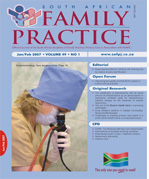Interventions to Facilitate Smoking Cessation
Keywords:
Smoking cessation, nictotine
Abstract
Tobacco use, primarily cigarette smoking, is the leading cause of preventable morbidity and mortality in the United States, and nearly one third of those who try a cigarette become addicted to nicotine. Family physicians, who see most of these patients in their offices every year, have an important opportunity to decrease smoking rates with office-based interventions. The U.S. Public Health Service recommends that primary care physicians use the five A’s (Ask, Advise, Assess, Assist, and Arrange) model when treating patients with nicotine addiction. Physicians can improve screening and increase cessation rates by asking patients about tobacco use at every office visit. Behaviour modification can improve long-term smoking cessation success; even brief (five minutes or less) advice on smoking cessation during an office visit can increase cessation rates. The effectiveness of non-pharmacologic treatments generally is lower; therefore, pharmacotherapy is recommended for smokers who are willing to attempt cessation, unless medical contraindications exist. The pharmacologic agents approved by the U.S. Food and Drug Administration for treatment of tobacco dependence include bupropion (a non-nicotine therapy) and nicotine replacement therapies in the form of a gum, patch, nasal spray, inhaler, and lozenge. These agents have similar long-term success rates. Permission from the AAFP was granted to publish this article in the hardcopy only. Kindly refer to www.aafp.org or subscribe to the hardcopy of South African Family Practice.
Section
CPD
By submitting manuscripts to SAFP, authors of original articles are assigning copyright to the South African Academy of Family Physicians. Copyright of review articles are assigned to the Publisher, Medpharm Publications (Pty) Ltd, unless otherwise specified. Authors may use their own work after publication without written permission, provided they acknowledge the original source. Individuals and academic institutions may freely copy and distribute articles published in SAFP for educational and research purposes without obtaining permission.

